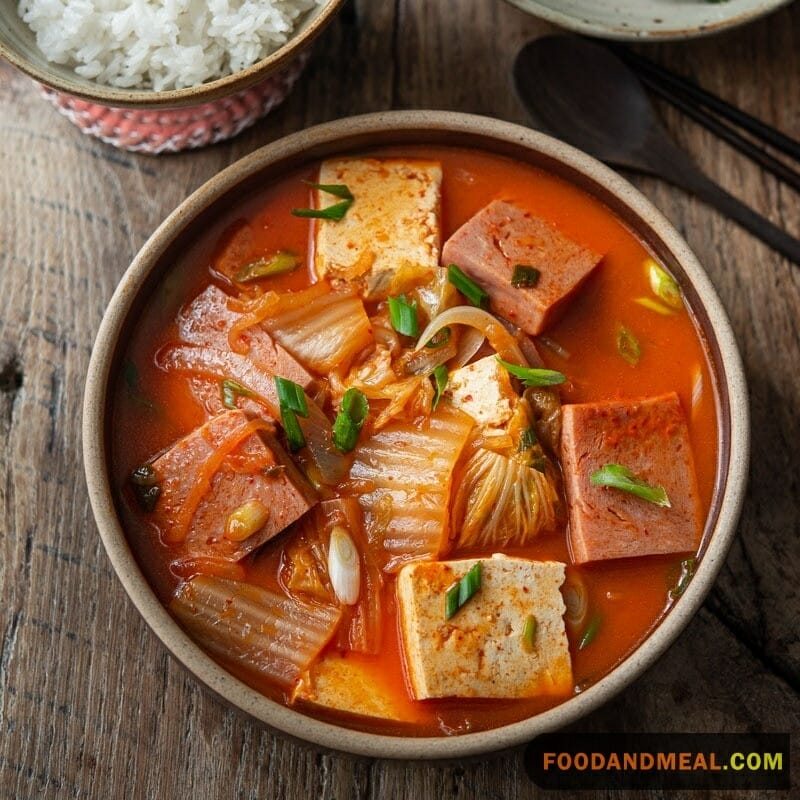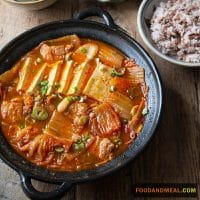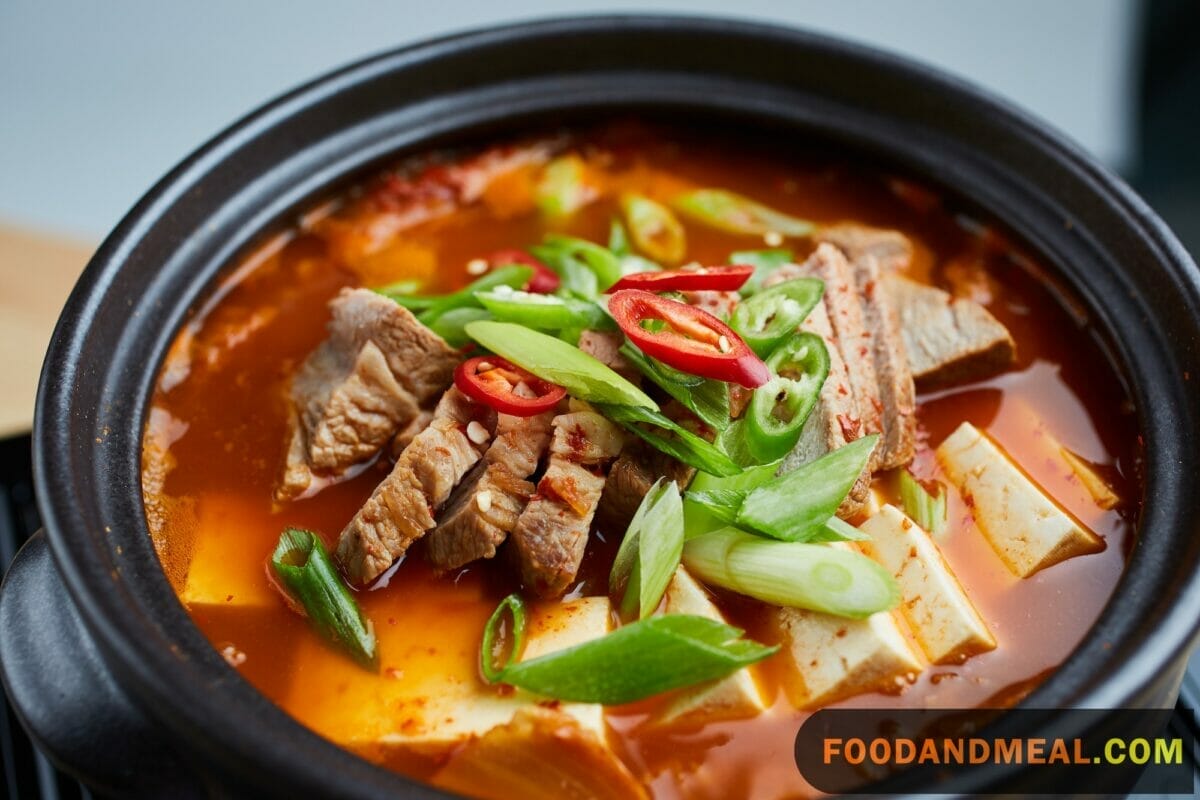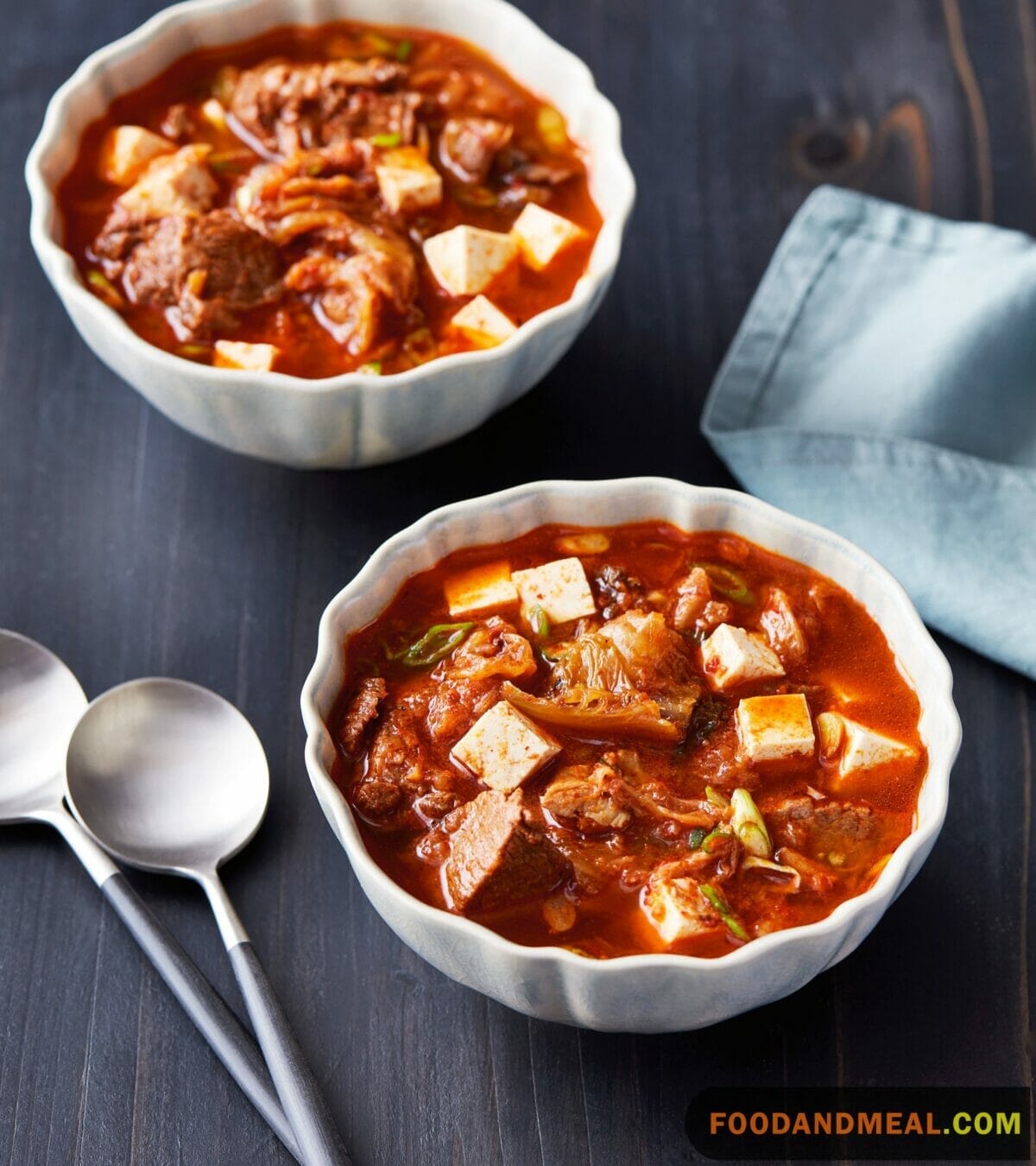As a child, I fondly remember my grandmother’s nourishing kimchi jjigae (kimchi stew) warming me up on frigid winter days. The spicy fermented cabbage and tender pork belly were the ultimate comfort food. Now, as part of the passionate team at Food and Meal sharing cultural recipes, I’m delighted to bring this soulful dish into your kitchens.
Kimchi jjigae holds a profoundly special place in my heart. It’s a versatile Korean staple – both a side dish on its own and an ingredient in countless recipes. As I gently drop the slippery cabbage into the steaming broth, I feel immense gratitude for my heritage passing down this tradition.
In my version, I use both pork and tofu for heartiness. Thinly sliced onions and zucchini give it a fresh crunch, while gochujang chili paste adds a touch of spice. Then I top each serving with scallions and a sprinkle of sesame seeds. This adds lovely color and texture.
As you gather with your loved ones on a cold evening, I hope this kimchi stew fills you up in body and spirit. Let it be a bridge connecting us across cultures through the universal language of food. Please tell me your stories! I’d be delighted to hear how this recipe makes its way into your lives.

Kimchi Stew Recipe

KIMCHI STEW
Ingredients
- 3/4 pound beef or pork, thinly sliced
- 1 tablespoon toasted sesame oil, divided
- 2 cups Napa Cabbage Kimchi (here), roughly chopped
- 1/2 sweet onion, chopped
- 2 garlic cloves, finely chopped
- 1 tablespoon gochujang
- 1 tablespoon gochugaru
- 1 tablespoon soy sauce
- 3 cups water
- 1⁄2 (12- to 14-ounce) block firm tofu, cubed
- 2 scallions, chopped
Instructions
- If using beef, sauté the meat in 1⁄2 tablespoon of the sesame oil in a stockpot for 2 to 3 minutes over medium-high heat. If using pork, you can halve or omit the oil.
- Add the kimchi and stir-fry for about 5 minutes.
- Add the remaining 1⁄2 tablespoon sesame oil, the onion, garlic, gochujang, gochugaru, and soy sauce and stir to combine. Add the water, stir, and bring to a boil. Reduce the heat to medium and simmer for 15 minutes. Then add the tofu and simmer for 15 more minutes.
- Serve hot, sprinkled with the scallions.
Video
Notes
INGREDIENT TIP: If using beef, tenderloin is best, but you can use tougher cuts like stew beef and simmer the stew longer. If using pork, then bacon, pork belly, or SPAM work well. If using canned tuna, add it in step 3.
Nutrition
© Food And Meal
This website provides approximate nutrition information for convenience and as a courtesy only. Nutrition data is gathered primarily from the Spoonacular Database, whenever available, or otherwise other online calculators.
Cooking Tips

When preparing kimchi jjigae, I have a few suggestions for making it just right. First, use high-quality, properly fermented kimchi with that perfect balance of sour and spice. This builds a flavorful base. Second, let the stew simmer slowly so the pork belly becomes fall-apart tender. And third, add the kimchi towards the end to retain some crunch.
In terms of toppings, I love finishing each bowl with a sprinkle of toasted sesame seeds and snip of fresh scallions. This adds a pop of color and texture. You could also top it with a fried egg for extra protein. However you choose to customize this stew, I hope it fills your spirit as you gather for a cozy dinner on a cold night. Please tell me your stories – I’d be delighted to hear how this recipe makes its way into your lives across cultures.
Serving Suggestions

For a fusion of Korean and Japanese flavors, pair the robust Kimchi Stew with the richness of Japanese Sesame Lamb Hot Pot, creating a symphony of bold tastes. Opt for a classic blend of East and West by combining the savory notes of the stew with the heartiness of Stir-Fried Beef and Broccoli, offering a satisfying balance of textures. Indulge in an exotic union with the aromatic Thai Red Meatball Curry, where the spiciness of kimchi marries seamlessly with Thai curry complexity. For a delightful marriage of Korean and Japanese elements, complement the zesty Kimchi Stew with the comforting flavors of Japanese Mushroom Tofu Hot Pot. Embrace a creative fusion with Korean-Style Sweet Potato Pizza, where the sweetness of potato perfectly contrasts with the boldness of kimchi. Refresh your palate with a Korean Watermelon Soju Cocktail, creating a harmonious balance with the warmth of the stew. These diverse pairings are crafted to celebrate the versatility of Kimchi Stew, ensuring each bite is a culinary journey.
FAQs: Your Guide to Kimchi Stew Queries

- Is kimchi stew healthy? Yes, kimchi stew is a healthy dish. Kimchi, a fermented vegetable, is rich in probiotics and nutrients. The stew often includes various vegetables, tofu, and sometimes meat, providing a well-rounded and nutritious meal.
- How do you eat Korean kimchi stew? Korean kimchi stew is typically enjoyed with a bowl of steamed rice. You can also pair it with other Korean side dishes, such as pickled vegetables or kimchi pancakes, for a complete and satisfying meal.
- Is kimchi stew supposed to be sour? Yes, kimchi stew is known for its slightly sour and tangy flavor, which comes from the fermentation process of kimchi. The balance of spiciness, sourness, and umami is what makes this stew unique and delicious.
- Is kimchi stew good for colds? Yes, kimchi stew is often considered a comforting dish that may help alleviate cold symptoms. The warmth, spiciness, and probiotics from kimchi can provide a soothing and nourishing experience during illness.
- Can I Adjust the Spice Level? Absolutely! The spice level can be customized by adjusting the amount of kimchi you use. Remember, a little goes a long way in adding heat.
- How Should I Store Leftovers? Leftover Kimchi Stew can be stored in an airtight container in the refrigerator. When reheating, add a splash of water to maintain its consistency.
- Can I Use Store-Bought Kimchi? Certainly! Opt for well-fermented and high-quality store-bought kimchi. It contributes to the robust and authentic flavors of the stew.
- What If My Stew Turns Out Too Salty? If your stew becomes saltier than desired, simply add a splash of water or unsalted broth while reheating. This will help balance the flavors.
- Can I Make Kimchi Stew in Advance? Indeed! Kimchi Stew reheats wonderfully, making it an excellent choice for meal prepping. Store it in the refrigerator and gently reheat for a comforting meal.
Conclusion
In conclusion, the journey through the world of Kimchi Stew has not only been a culinary exploration but also a celebration of its rich flavors, nutritional benefits, and cultural significance. Its unique combination of sourness, spiciness, and umami, derived from the fermented kimchi, creates a dish that tantalizes the taste buds and warms the soul. At Food and Meal, we believe in the power of food to bring joy, comfort, and cultural connections to our lives, and Kimchi Stew exemplifies these principles. Whether enjoyed as a remedy for colds, a comforting meal during chilly days, or a flavorful addition to your regular menu, this Korean dish offers a versatile and nourishing experience. Explore more recipes, culinary inspirations, and cultural delights at foodandmeal.com, where every dish becomes an invitation to discover the world through food. Join us in this delightful culinary journey, and may your Kimchi Stew adventures be filled with warmth, flavor, and the joy of shared meals.
Hi! I'm Nazia of ‘Nazia Cooks’, a self-taught baker and cook residing in Chennai. Rooted in the rich South Indian culinary landscape, my palate has expanded to embrace global flavors. I revel in crafting fusion dishes, melding traditions to birth unique tastes.



